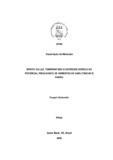| dc.creator | Stefanello, Raquel | |
| dc.date.accessioned | 2017-05-22 | |
| dc.date.available | 2017-05-22 | |
| dc.date.issued | 2005-04-08 | |
| dc.identifier.citation | STEFANELLO, Raquel. The effect of light, temperature and hydric stress in
the physiologic potentiality of seeds of anise, fennel and dill. 2005. 57 f. Dissertação (Mestrado em Agronomia) - Universidade Federal de Santa Maria, Santa Maria, 2005. | por |
| dc.identifier.uri | http://repositorio.ufsm.br/handle/1/5011 | |
| dc.description.abstract | The objective of that work was to evaluate the effects of light, of temperature and of hydric stress in the germination and vitality of seeds of anise, fennel and dill. The experiment was led in two stages. In stage I, the seeds were placed to germinate to constant temperatures of 20, 25, 30 ºC and alternate temperatures of 20-30 ºC in the presence and absence of light. The assessed parameters were: germination percentage, first count, index of germination speed, length and dry mass of seedlings. In stage II, the seeds were placed in soaked substratum in polyethylene glicol (PEG 6000) in the osmotic potentials equivalent to zero; -0,05; -0,10; -0,15; - 0,20; -0,25; -0,30 MPa. Germination percentage, first count and index of germination speed were evaluated. In stage I, the procedure employed was reached by chance, with the data submitted to variance analysis and to the Tukey test to a 5% of probability, and in stage II, analysis of polinomial regression was used. According to the results, it is possible to conclude that germination of seeds anise, fennel and dill happen in presence and absence light, however the manifestation of the vigor is favored by light. The germination of dill seeds is larger in light presence. The seeds anise, fennel and dill, without dormancy, germinate better in the constant temperatures of 20 and 25 °C and temperature of 30 °C is not adapted for germination test in these species. The dill seeds are more tolerant to hydric stress than the anise and fennel seeds. The decrease of the osmotic potentials reduces the germination and vigor of seeds anise, fennel and dill, being the most affected vigor than germination. The germination is reduced drastically, starting from -0,1 MPa for fennel and -0,2 MPa for dill, when there is decrease of osmotic potentials with polyethylene glicol 6000. | eng |
| dc.format | application/pdf | por |
| dc.language | por | por |
| dc.publisher | Universidade Federal de Santa Maria | por |
| dc.rights | Acesso Aberto | por |
| dc.subject | Pimpinella anisum | por |
| dc.subject | Foeniculum vulgare | por |
| dc.subject | Anethum graveolens | por |
| dc.subject | Germinação | por |
| dc.subject | Estresse hídrico | por |
| dc.subject | Impinella anisum | eng |
| dc.subject | Foeniculum vulgare | eng |
| dc.subject | Anethum graveolens | eng |
| dc.subject | Germination | eng |
| dc.subject | Hydric stress | eng |
| dc.title | Efeito da luz, temperatura e estresse hídrico no potencial fisiológico de sementes de anis, funcho e endro | por |
| dc.title.alternative | The effect of light, temperature and hydric stress in the physiologic potentiality of seeds of anise, fennel and dill | eng |
| dc.type | Dissertação | por |
| dc.description.resumo | O objetivo desse trabalho foi avaliar os efeitos da luz, da
temperatura e do estresse hídrico na germinação e no vigor de sementes de anis, funcho e endro. O experimento foi conduzido em duas etapas. Na etapa I, as sementes foram colocadas para germinar nas temperaturas constantes de 20, 25, 30 ºC e alternada de 20-30 ºC na presença e ausência de luz. Os parâmetros avaliados foram: percentagem de
germinação, primeira contagem, índice de velocidade de germinação, comprimento e massa seca das plântulas. Na etapa II, as sementes foram colocadas em substrato embebido em solução de polietileno glicol (PEG 6000) nos potenciais osmóticos correspondentes a zero; -0,05; -0,10;
-0,15; -0,20; -0,25; -0,30 MPa. Avaliou-se a percentagem de germinação, primeira contagem e índice de velocidade de germinação. O delineamento utilizado foi o inteiramente casualizado com os dados submetidos à análise de variância e teste de Tukey a 5% de probabilidade, na etapa I e análise de regressão polinomial, na etapa II. Conforme os resultados
pode-se concluir que a germinação das sementes de anis, funcho e endro ocorre tanto na presença quanto na ausência de luz, porém a manifestação do vigor é favorecida pela luz. A germinação das sementes de endro é maior na presença de luz. As sementes de anis, funcho e endro, sem dormência, germinam melhor nas temperaturas constantes de 20 e 25 °C e a temperatura de 30 °C não é adequada para o teste de
germinação nestas espécies. As sementes de endro são mais tolerantes ao estresse hídrico que as sementes de anis e funcho. A diminuição dos potenciais osmóticos reduz a germinação e o vigor das sementes de anis, funcho e endro, sendo o vigor mais afetado que a germinação. A
germinação é reduzida drasticamente, a partir de -0,1 MPa para funcho e -0,2 MPa para endro, quando há diminuição dos potenciais osmóticos com polietileno glicol 6000. | por |
| dc.contributor.advisor1 | Garcia, Danton Camacho | |
| dc.contributor.advisor1Lattes | http://buscatextual.cnpq.br/buscatextual/visualizacv.do?id=K4702954P8 | por |
| dc.contributor.referee1 | Menezes, Nilson Lemos de | |
| dc.contributor.referee1Lattes | http://buscatextual.cnpq.br/buscatextual/visualizacv.do?id=K4788277Y1 | por |
| dc.contributor.referee2 | Roversi, Teresinha | |
| dc.contributor.referee2Lattes | http://buscatextual.cnpq.br/buscatextual/visualizacv.do?id=K4723592A4 | por |
| dc.creator.Lattes | http://buscatextual.cnpq.br/buscatextual/visualizacv.do?id=K4771756Z3 | por |
| dc.publisher.country | BR | por |
| dc.publisher.department | Agronomia | por |
| dc.publisher.initials | UFSM | por |
| dc.publisher.program | Programa de Pós-Graduação em Agronomia | por |
| dc.subject.cnpq | CNPQ::CIENCIAS AGRARIAS::AGRONOMIA | por |


